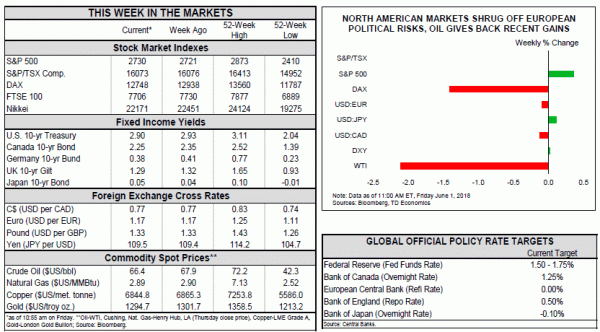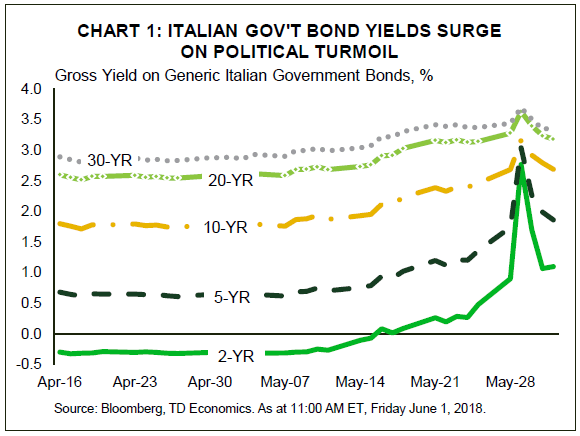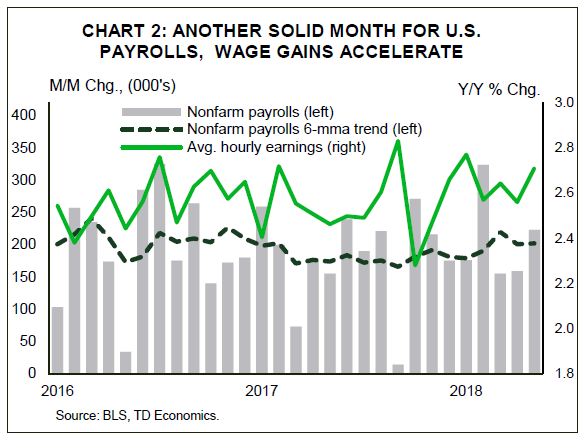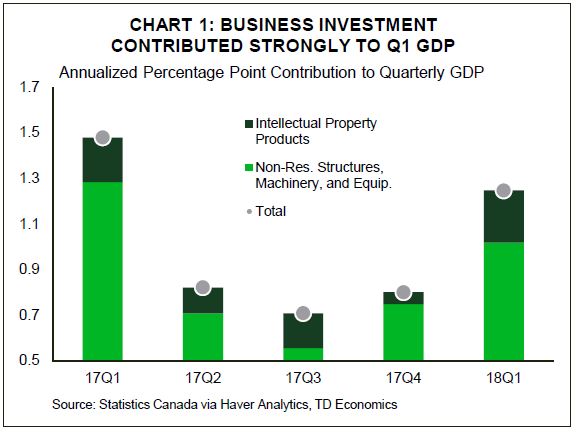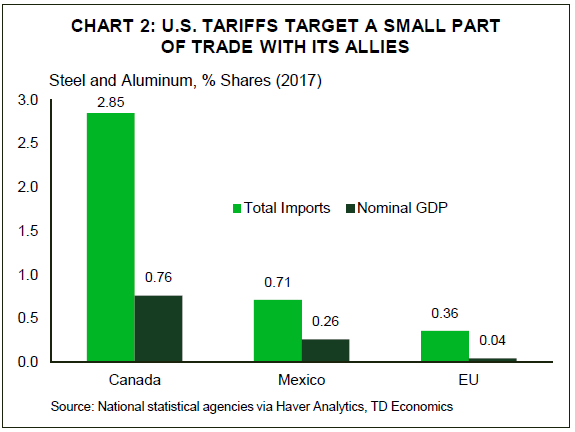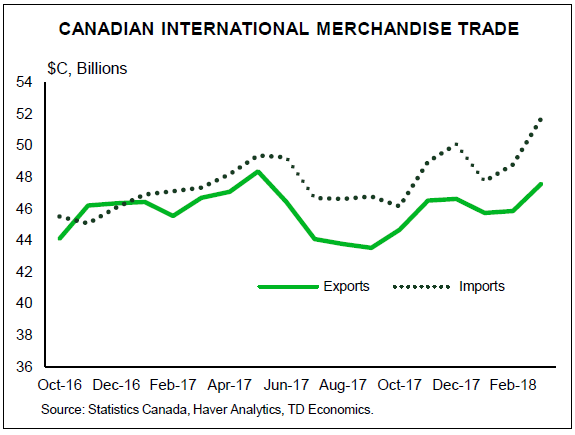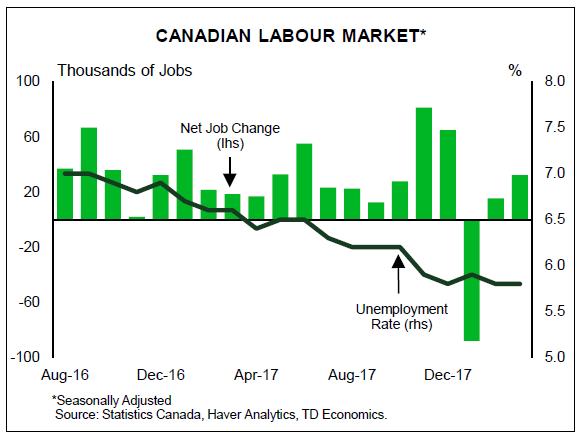U.S. Highlights
- Fears of fresh elections in Italy spooked investors, who unloaded Italian bonds – sending yields on short-term government debt skyrocketing. By the end of the week, Italy’s populist coalition was finally allowed to form a government. But far from closure, this likely marks the beginning of a new chapter that will test the Eurozone’s stability.
- The U.S. turned up the heat on trade tensions by announcing that it would go ahead with tariffs on $50B of Chinese goods, and that it would end the exemption on steel and aluminum tariffs for Canada, Mexico and the EU.
By the end of the week, markets shrugged off the latest developments in - Europe and on trade, supported by a string of positive U.S. data – in particular, a very healthy May payrolls gain of 223k and wage growth that accelerated to 2.7% y/y. The latest data cement the case for a Fed rate hike at its June meeting.
Canadian Highlights
- The federal Liberal government announced its purchase of the Trans Mountain pipeline. Over time, this should improve the ability for Canada to export crude oil to international markets.
- Canadian economic activity expanded at a 1.3% pace in the first quarter, below trend but with solid underlying details.
- Although the Bank of Canada held rates this week, but set up the next rate hike for July. However, external developments, including U.S. tariffs on Canadian steel and aluminum, continue to pose material downside risk to Canadian outlook.
U.S. – Nessun Dorma (No One Sleeps)
The theatrical twists and turns of this week’s events are worthy on an opera, with the opening act set in Italy. Political turmoil and fears that new elections in Europe’s fourth largest economy could strengthen the grip of Eurosceptic parties spooked investors, who began to unload Italian assets. This sent yields on short-term government debt skyrocketing (Chart 1). Investors also steered clear of other southern European debt, with short-term Spanish, Greek and Portuguese bonds also selling off. Concerns regarding new elections subsided as the week wore on, and these moves began to reverse course. By the end of the week the populist coalition was allowed to form a government. Still, the fact that the new Italian government – which favors tax cuts and spending increases – is likely to clash with the E.U. on a number of issues, suggests that this is merely a new chapter which may further tests the bloc’s stability. The sheer size of Italy’s economy – roughly ten times that of Greece – will warrant special attention.
Markets were thrown another curve ball when the White House announced that it would be pushing ahead with tariffs on $50B of Chinese goods and end the exemption on steel and aluminum tariffs for the E.U., Canada and Mexico. These normally close allies pledged to challenge the tariffs through the WTO and NAFTA channels and levy retaliatory tariffs. At around $12.6B and $7.7B of U.S. products targeted by Canada and the E.U. respectively, and an estimated $4B in trade with Mexico, the amount of affected trade is still quite small. But the wide list of products marked for tariffs, which stretch from agricultural products to motorcycles, are sure to strike a sour cord with the U.S. Ultimately, the tariffs will make goods more expensive for the American consumer. In a prior analysis, in which we expected the exemptions for the allies to stay, we estimated that the tariffs would have a muted direct impact on U.S. economic activity and inflation. The recent events make us more confident that while the impact on U.S. economic activity is still expected to be limited, the tariffs are likely to boost consumer price inflation by at least 0.1 percentage points this year and next.
Behind the curtain of the unfolding Italian and trade sagas, U.S. economic data was broadly positive. American consumers were back in full force in April, with personal spending rising by a robust 0.4% in real terms, building on a solid March print. The back-to-back gains point to a 3.5% rebound in second quarter consumer spending after a soft first-quarter print (1% Q/Q ann.). This narrative is further reinforced by a strong labor market. In May, payrolls gains (223k) beat expectations, the unemployment rate fell to an 18-year low (3.8%) and wage growth accelerated to 2.7% y/y (Chart 2). Rounding out the good economic news was an above-consensus print in the ISM manufacturing index, which pointed to manufacturing activity accelerating in May.
The latest data cement the case for a Fed rate hike on June 13th. But this is no time to fall asleep, with further policy rate normalization also requiring a watchful eye on developments out of Europe and the potential fallout from heightened trade tensions. For now, Nessun Dorma.
Canada – One Step Forward, Two Steps Back
European politics dominated market moves in this last week of May that left many wondering if they should sell before they go away on summer vacation. Euro concerns returned with a vengeance, sending peripheral country yields shooting upward, and overshadowing some positive domestic developments. By week-end however, some calm was restored on the back of positive political developments in Italy and Spain.
The federal Liberal government announced plans this week to purchase the Trans Mountain pipeline from Kinder Morgan at a cost of $4.5 billion. Although opposition to the pipeline remains, construction is slated to begin this summer. Over time this development should improve the shipment of Canadian crude to international markets and help it fetch a better price.
Statistics Canada reported this week that Canada’s economy expanded at a 1.3% annualized pace in the first quarter. This was in line with the Bank of Canada’s April MPR forecast, but was softer than the higher frequency data received over the past six weeks was suggesting. Overall, the underlying details of the first quarter report were solid. Business investment continued to climb, and household disposable income growth rose 3.7% (Chart 1). However, exports contributed little to output for the second consecutive quarter despite a firming in travel services.
As expected, the housing market exerted a material drag on economic activity in the first quarter. The B-20 mortgage guidelines that came into effect at the start of the year drove a resale activity decline of over 40% in the ensuing three month period. However, there are signs that the market is stabilizing, and a solid outlook for income growth is likely to see a gradual rebound in the housing market take hold later this year.
Given the continued strong performance of the Canadian economy, it’s unsurprising that the Bank of Canada’s monetary policy decision this week to leave interest rates unchanged carried a hawkish outlook. The economy is likely to grow at an above-trend 2.0% pace this year, eating up what little slack remains. As such, although headline inflation is likely to tick up a notch due to higher gas prices, trend measures of inflation should remain anchored near the midpoint of the Bank of Canada’s 1-3% target. This should provide enough conviction for the Bank of Canada to raise interest rates by 25 basis points at its meeting in July, with two more likely next year.
That said, it’s clear that global developments out of the Bank of Canada’s control are being closely monitored. Volatile global financial markets have driven capital out from vulnerable emerging market economies, and any stresses in these regions could potentially spillover into trade partners. Moreover, yesterday’s decision by the U.S. administration to go forth with steel and aluminum tariffs on Canada, Mexico, and the EU elevates the chance of a cold trade war turning hot. Although the direct economic impacts of the tariffs are estimated to be relatively small, the blow to confidence and the potential for supply chain disruptions could result in an outsized negative drag on economic activity in these regions (Chart 2). As a result, the Bank of Canada is likely to continue to maintain its gradual approach in removing stimulus.
Canada: Upcoming Key Economic Releases
Canadian International Trade – April
Releases Date: June 6, 2018
Previous Result: -$4.1bn
TD Forecast: -$3.4bn
Consensus: N/A
We expect the international trade deficit to narrow to $3.4bn from $4.1bn in April, reflecting a pullback in imports following last month’s blockbuster report. Exports should see little change as strength in energy products offsets a decline in aerospace, which contributed near a full percentage point to March export growth, and weak auto exports as presaged by advance US trade data. On the other side of the equation, imports should come under pressure as a number of outsized moves unwind. Motor vehicles and consumer goods are both prime candidates after they combined to contribute 3.2% to the advance in March imports. Looking ahead, we expect trade to make a positive contribution to GDP growth in Q2 after three quarters as a headwind to domestic demand.
Canadian Employment – May
Release Date: June 8, 2018
Previous Result: -1k, unemployment rate: 5.8%
TD Forecast: 8k, unemployment rate: 5.9%
Consensus: N/A
TD looks for the economy to add a relatively modest 8k jobs in May, roughly 10k below the six month trend, while a rebound in part-time employment should add to the downbeat tone. Full time job growth has outperformed part time by 160k over the last two months, leaving us biased towards a correction. Our base case is for unchanged wage growth but risks are tilted towards incremental gains on modest base effects. However, we will be on alert for any unexpected weakness after SEPH wage growth registered a sharp decline in March – while the two do not display a lagged relationship, a harmonized deceleration in wages would not go unnoticed by the Bank of Canada. After a pullback in labour force participation last month, we expect a partial rebound in May to drive the unemployment rate higher to 5.9%.




